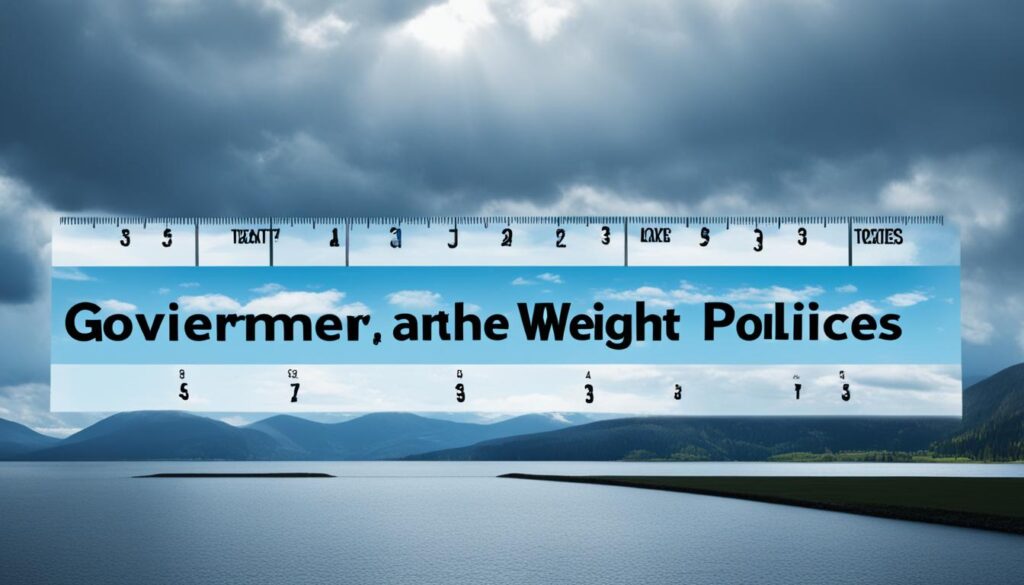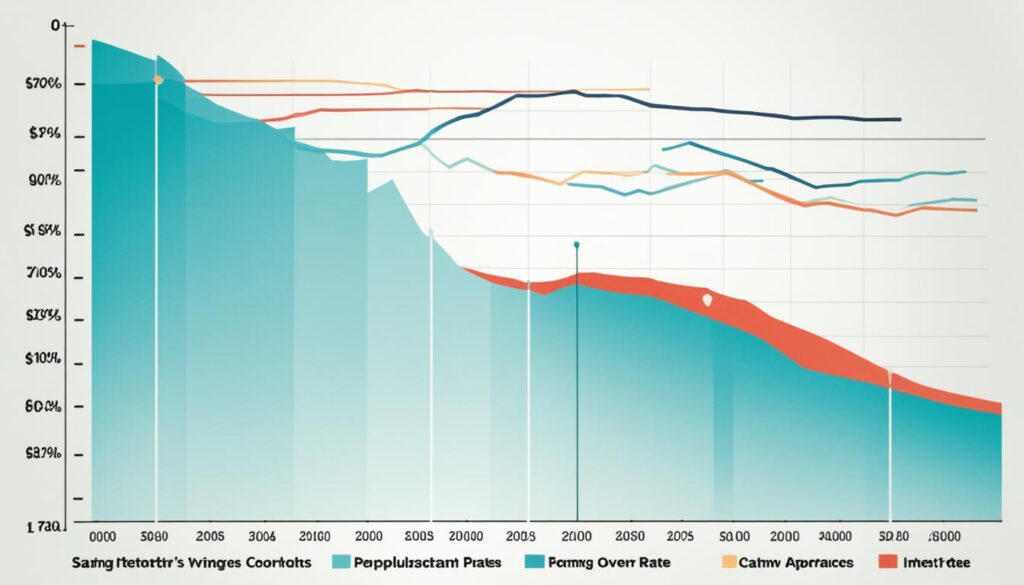In the realm of personal finance, understanding the Economic Factors Impacting Savings is quintessential for crafting an effective financial strategy. For decades, savings rates in industrial nations have witnessed a notable ebb and flow, shaped by multifaceted economic phenomena. From the evolution of budgetary policy to demographic trends, interest rates, and levels of household wealth, each component exerts a unique influence on how individuals accumulate savings over their lifetime. Such an intricate tableau requires individuals to stay informed and agile, adapting their savings strategies to secure their financial future amidst changing economic landscapes.
Key Takeaways
- Savings rates are shaped by a complex interplay of economic and policy changes.
- Understanding government policy’s role is crucial for optimal savings decisions.
- Life-cycle phases like earning peaks inform prudent savings strategies.
- Anticipating future income and expenses is central to saving behavior.
- Financial foresight and adaptability serve as pillars of a robust financial strategy.
- Keeping abreast of economic patterns bolsters confidence in financial planning.
Understanding the Savings Rate and Its Importance
Savings rate is a critical metric that reflects the economic stability and potential for growth within an individual’s finances or a national economy. Grasping its nuances helps appreciate how changes in disposable personal income, time preference, and income levels can influence future investment and consumption patterns.
What Constitutes the Savings Rate?
The savings rate is defined as the portion of disposable personal income that’s set aside for future use rather than current expenditures. This figure is a vital sign of financial health and foresight, indicating the capability to withstand economic fluctuations and plan for long-term objectives.
The Relationship Between Disposable Income and Savings
A direct correlation exists between disposable personal income and the capacity to save. When disposable income increases, individuals often have greater flexibility to allocate funds toward savings. This is subject to variations based on economic conditions and personal financial goals, yet, as a general rule, higher disposable income paves the way for an increase in savings rates.
Time Preference and Its Impact on Saving Behaviors
Time preference is a key economic concept that influences saving behaviors. It refers to the value individuals assign to immediate rewards compared to those they expect to receive in the future. A lower time preference indicates a greater inclination to save and defer immediate spending in favor of accumulating wealth over time. Conversely, a higher time preference often aligns with a preference for present consumption, which may reduce the propensity to save.
Personal saving habits, shaped by time preference, directly affect income levels and, consequently, economic stability. By analyzing these factors, we can begin to understand the underlying drivers of saving rates and craft more effective financial strategies for individuals and policy approaches for nations.
Analyzing Government Policies and Their Impact on Private Savings
Government policies play a pivotal role in shaping private savings, often steering the economic climate towards conducive conditions for fiscal policy maneuvers and overall economic growth. A nuanced understanding of this dynamic is crucial in managing national financial health. Through various theoretical lenses, analysts have attempted to decipher the complex relationship between state actions and individual saving behaviors.
The Ricardian equivalence is one such concept that suggests an increase in government deficit will not change the aggregate demand due to the anticipation that people will save today to pay off future taxes; however, the empirical evidence surrounding this theory is still debated. This back-and-forth of theories underscores the intricate balance between government policies and private savings.
- Neoclassical view: Private savings fill the gap left by government deficits.
- Keynesian perspective: Government spending can stimulate or dampen private savings depending on the economic cycle.
- Ricardian standpoint: Government borrowing today leads to increased private savings in anticipation of future tax liabilities.
Here, we present a comparative analysis of different fiscal situations and how they have historically impacted private savings:
| Fiscal Scenario | Private Savings Increase | Private Savings Decrease | Neutral Impact |
|---|---|---|---|
| Government Budget Surplus | Lower need for private saving as a buffer | – | Higher confidence in government financial health |
| Government Budget Deficit | In accordance with Ricardian equivalence | Increased public spending | Uncertainty over government’s long-term impact |
In sum, while the relationship between government policies and private savings may not be straightforward, there is a discernible impact that stimulus measures and budgetary adjustments have on the financial strategies adopted by individuals and families seeking to secure their economic future.
“The essence of government policy is often its intrinsic capability to either bolster confidence and stimulate savings or inadvertently dampen the impetus to save through fiscal largesse.”
As discussions on fiscal policy and its implications for private savings continue, it is paramount that policymakers balance the short-term goals of stimulating economic growth with the long-term necessity of fostering a robust culture of saving among citizens.

Economic Factors Impacting Savings
Understanding the multifaceted economic factors influencing savings is essential for both individuals seeking to enhance their fiscal health and policy-makers aiming to bolster economic stability. At the core of these factors are budgetary policies, the interplay between interest rates and inflation, and the critical role played by the age structure of the population.
The Role of Budgetary Policies in Savings Rates
Government spending and taxation are two powerful levers that can significantly influence private savings rates. A fiscal policy that emphasizes low taxes might increase disposable income, thereby providing a greater capacity for personal savings. Conversely, an increase in government spending could reduce the need for private savings, as public investment may take precedence over individual saving initiatives.
Effects of Inflation and Interest Rates on Saving
Inflation erodes purchasing power, which can have a paradoxical effect on savings. While some may save more to counteract the impact of rising prices, others will find it difficult to put money aside. Fluctuating interest rates, on the other hand, can either encourage or dissuade a person from saving. High-interest rates typically incentivize savings by yielding better returns, whereas low rates may prompt increased consumption or investment in higher-risk assets.
Demographics: How the Age Structure of the Population Influences Savings
Diverse age groups contribute differently to the collective savings rate due to variations in earning capacity, lifetime incomes, and consumption patterns. For example, prime-aged workers, who are at the zenith of their earning potential, typically boast higher saving rates in anticipation of retirement. In contrast, younger individuals may be focused on consumption and investment in their futures through education or homeownership, while the elderly may be drawing down on their savings.

Each of these economic factors and life stages must be carefully considered when analyzing the broader financial landscape and its impact on personal savings behavior.
Influence of Income and Employment Levels on Savings Decisions
When anchoring our discussion on personal finance, we must consider how income levels and employment levels play pivotal roles in shaping saving decisions. An upturn in an individual’s wage, characterized by higher lifetime earnings, commonly augments their capacity to set aside a proportion of their income for future needs. This propensity to save dovetails with an individual’s sense of security regarding their monetary inflows. In essence, economic stability contributes to heightened consumer confidence, which correlates directly with an uptick in savings and investment behaviors.
Mainstream economic theory suggests that employment – particularly its stability – is a cornerstone affecting how and when individuals save. In an environment where job security is perceived to be high, people tend to project a continuity of income, allowing them to confidently plan for retirement or unforeseen events requiring fiscal resilience. On the flip side, uncertainty in employment can usher in a cautious approach to spending, thereby influencing saving rates markedly. The fulcrum around which these behaviors balance is the reliable availability of promising investment opportunities that assure individuals of growth in their stored wealth, thus reinforcing the saving culture.
The symbiosis between earning capability and saving inclination could not be more pronounced than in the examples of high-earning demographics. As income thresholds escalate, a saturation point appears to be reached where the marginal propensity to consume dilutes, and the savings rate stabilizes. Nevertheless, this dynamic interplay offers insight into the mechanisms that drive personal financial planning and underscores the critical role that robust income and employment landscapes hold in bolstering an individual’s, and by extension, the nation’s financial future.
Can Economic Factors Impact Savings Goals and How Can They Be Adapted Over Time for Financial Growth?
Economic factors can heavily influence savings goals adaptation over time. Inflation, market fluctuations, and job stability can hinder long-term financial growth. To adapt, consider diversifying investments, adjusting budgeting strategies, and seeking professional financial advice. Flexibility is key in managing savings goals adaptation over time for optimal financial growth.
FAQ
What Constitutes the Savings Rate?
The savings rate is defined as the percentage of disposable personal income that is saved rather than spent by an individual or household. It’s a key indicator of financial health and future investment potential.
The Relationship Between Disposable Income and Savings
Disposable income and savings are interconnected. Higher levels of disposable income allow an individual to increase both consumption and saving. However, the savings rate reflects a balance between present consumption needs and future saving goals.
Time Preference and Its Impact on Saving Behaviors
Time preference refers to the relative value individuals place on present benefits versus future benefits. A lower time preference means future benefits are valued more, which translates into a higher propensity to save rather than consume.
How Do Government Policies Influence Private Savings?
Government policies affect private savings through taxation, government spending, and fiscal stability. Policies can incentivize or dissuade individuals from saving based on the economic environment they create.
The Role of Budgetary Policies in Savings Rates
Budgetary policies, such as changes in taxes or government spending, can alter disposable income and incentivize private savings. Depending on the policy, these changes can either encourage or discourage individuals from saving.
Effects of Inflation and Interest Rates on Saving
Inflation reduces the value of saved money, which can discourage saving if the rate of inflation is higher than the interest earned on savings. Conversely, higher interest rates can encourage saving by offering greater returns on saved funds.
Demographics: How the Age Structure of the Population Influences Savings
The age structure of the population affects savings as different age groups tend to have different saving patterns. For example, prime-aged workers near peak earning typically save more compared to younger individuals or retirees.
Influence of Income and Employment Levels on Savings Decisions
Income and employment levels heavily influence savings decisions; higher earnings and stable jobs usually lead to an increased capability and willingness to save, while economic uncertainty or job instability may prompt a greater focus on liquidity and less on saving.

